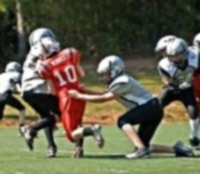Young Athletes – Head and Neck Injuries
By Dr. Cynthia Horner
As a family health chiropractor I am often asked by parents if they should be concerned about head and neck injuries from hits to the head their young athletes receive in football, soccer, and some martial arts. Surprisingly high school and college football players receive as many as 1,600 blows to the head in a season that often result in head and neck injuries later in life.
How hard they are hit does matters but how many times they are hit seems to matter more. It has been found that many small hits to the front and side of the head causes more brain damage than one large blow because the brain and surrounding tissue does not have time to heal and get strong before the next impact.
Brain changes found at the autopsies of those who received head injuries can be divided into two groups:
1) Alzheimer like degenerative changes – affecting memory emotions, learning and thinking ability. Symptoms of staggering gait, erratic behavior, amnesia and depression don’t appear until 20 to 30 years after the head injury.
2) Muscle control problems – effect three out of twelve athletes who develop symptoms from impact head injuries. This motor neuron dysfunction is similar to amyotrophic lateral sclerosis or Lou Gehrig’s disease affecting voluntary muscle movement.
New research for impact head and neck injuries
Researchers have found a build up of a cell killing protein called tau in the brains and spinal cords of athletes who have experienced mild to moderate head injury resulting in brain trauma, even those who died of unrelated causes. It seems to be present in all who experience impact injuries to the head. Researchers hope to be able to detect this protein in the living to monitor the effects that hits to the head have on the brain and repair it before permanent changes take place.
I have found a strong healthy neck can reduce the affects of the forces to the head reducing the chance of a serious head injury. Advanced technology used in helmets for football players and protective headgear for boxers and kick boxers is reducing the severity of head and neck injuries in many young athletes. I feel parents should be concerned and cautious but not worried as their children participate in recreational sports and more concern is warranted as young athletes become more competitive.
What I have learned from my patients: “We all want what is best for our children.”
